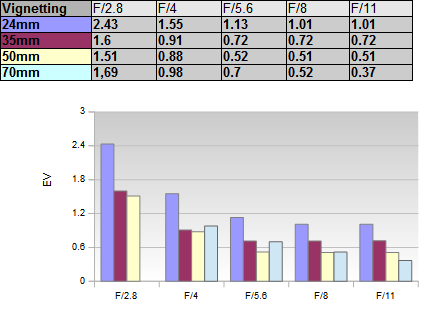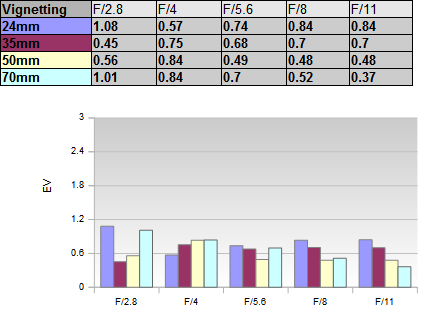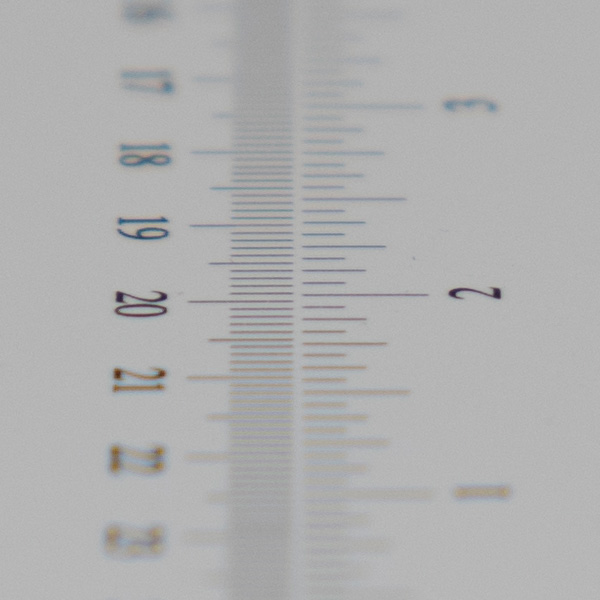|
Sony FE 24-70mm f/2.8 GM ( SEL2470GM ) - Review / Lab Test - Analysis |
|
Lens Reviews -
Sony Alpha (Full Format)
|
|
Page 2 of 2

Distortion
The Sony lens produces the usual standard zoom lens pattern of strong barrel distortions at the wide end, switching to pincushion distortion at tele settings. A barrel distortion of ~2.9% at 24mm is about average here but the pincushion distortion of ~1.9% at 70mm is on the high side. That's the native characteristic of the lens. If you prefer to rely on Sony's image auto-correction - and most will probably do anyway - this is all of lesser concern, of course.
Vignetting
There are no surprises in terms of vignetting. The original characteristic produces substantial vignetting at f/2.8 which is most pronounced at the 24mm setting (2.4 EV). Stopping down to f/4 improves the issue substantially. At 24mm you may still prefer to stop down to f/5.6 to reduce the issue to a manageable degree.
 If you enable image auto-correction the vignetting is substantially reduced, of course, although this comes at cost of increased noise in the image corners.
If you enable image auto-correction the vignetting is substantially reduced, of course, although this comes at cost of increased noise in the image corners.

MTF (resolution)
Sony's 42 megapixel sensor is quite a challenge regarding the required lens quality for exploiting its potential. The Sony FE 24-70mm f/2.8 GM does a good job here but it's not unworldly great. The image center is breathtakingly sharp at mainstream settings (except maybe at 70mm @ f/2.8). The image borders/corners aren't quite on that level though. They are fair at 24mm f/2.8 but improve to good to very good levels when stopping down to f/4. The border quality is better at 35mm at f/2.8 whereas the corner remains a little soft here. The overall performance decreases at 50mm and 70mm but it's certainly sharp at f/5.6 and f/8. The near-center performance is impressively high at 50mm and 70mm even at fully open aperture. Diffraction has a higher impact from f/11 onward.
The amount of field curvature is low. The centering quality of the tested sample was good but not stellar.
Please note that the MTF results are not directly comparable across the different systems!
Below is a simplified summary of the formal findings. The chart shows line widths per picture height (LW/PH) which can be taken as a measure for sharpness.
If you want to know more about the MTF50 figures you may check out the corresponding Imatest Explanations
Chromatic Aberrations (CAs)
The amount of lateral chromatic aberrations (color shadows at the image borders) is comparatively high at 24mm/35mm with an average pixel width of 2px at the image borders. Please note that the 42 megapixel sensor of the test camera amplifies such flaws. However, even so, we expected somewhat better result here. CAs are a lesser issue at the long end of the zoom range.

Bokeh
At the time Sony announced their new GM lenses, they were claimed to have a superior bokeh due to Sony's new XA element. The XA element is supposed to deliver clean highlight discs due to precision manufacturing. We'll not dispute that the Sony FE 24-70mm f/2.8 GM delivers a better than average bokeh but it is certainly not flawless.
It may well be that the XA element alone is superior to other element types but here it is still accompanied by two aspherical elements and as you can see below, these two are probably introducing the usual onion-like substructure in highlight discs plus some outlining ... just like in many other standard zoom lenses. However, what you can also spot in the sample crop below - the aperture is shaped by 9 blades and this helps to maintain a circular highlight disc even at f/5.6. As usual the circular shape of the disc deteriorates in the image corners though.
 The quality of the "general" blur is actually very smooth in the critical image background (left crop below) and still pretty good in the foreground (right).
The quality of the "general" blur is actually very smooth in the critical image background (left crop below) and still pretty good in the foreground (right).
 Note: the samples were taken at 70mm here.
Note: the samples were taken at 70mm here.
Bokeh Fringing / Longitudinal Chromatic Aberrations (LoCA)
So-called bokeh fringing is an effect that occurs around the focus point (on the Z-axis). It's visible as halos of different colors in out-of-focus areas - magenta (red + blue) in front of the focus point and green beyond.
The Sony FE 24-70mm f/2.8 GM is fast - by zoom standards at least - and as such, it's exposed to potential bokeh fringing issues. You should be able to spot some false colors at f/2.8 in the sample crop below. The issue is reduced at f/4 and pretty much gone at f/5.6.
|
Move the mouse cursor over the f-stop marks below to observe the respective LoCAs
|
| f/2.8 |
f/4 |
f/5.6 |
|

|
Sample Images
Sorry but not this time. It's not that we didn't want to but the weather was dismal during the test period.
Verdict
Sony's marketing made some pretty aggressive statements at the time of the announcement of their new GM lineup. The Sony FE 24-70mm f/2.8 GM is the first GM lens that we tested here and while we are impressed by the quality, it didn't really blow off our socks either. Now please note again that lens was tested on a 42-megapixel sensor. This is challenging. e.g. Our full format Canon tests are now based on 50 megapixels and some of you may have noticed that many lenses struggle here as well. So keeping this in mind, the Sony FE 24-70mm f/2.8 GM is actually a very good lens indeed. The center quality is just great. The borders/corners may struggle a bit at f/2.8 (except at 35mm) but if you stop down the resulting image is sharp across the image field. Lateral CAs are a bit high at the wide-end. The vignetting characteristic is typical for a lens in this class - thus there's a high light falloff at f/2.8, especially at 24mm. As usual stopping down helps. Image distortions can be visible in critical scenes at the extreme ends of the zoom range. Activating image auto-correction will fix most of these secondary issues though.
If there is a single aspect that disappointed us it's the bokeh. Or to be precise - the difference between Sony's claim and reality. Generally, the bokeh is good for a standard zoom lens ... that is except for the rendition of highlight discs. Sony made quite a fuzz around clean highlight discs but the truth remains that they can be rather rough and they aren't any better than what we've seen from Canon or Nikon really.
The build quality of the Sony FE 24-70mm f/2.8 GM is extremely high. The materials are top-notch and the weather/dust sealing is the cream on the cappuccino here. However, at that price point, we expected no less and the competition is, again, no worse either. Anyway, if you want the best standard zoom lens in Sony E mount, this is certainly it. The Zeiss FE 24-70mm f/4 OSS is inferior at comparable aperture settings. A more difficult question may be whether such a big and heavy lens can make sense on a rather tiny mirrorless camera body. Now we have to admit that the balance of the setup is surprisingly good. However, we also thought that the combo is a little odd nonetheless.
Mechanical Quality:
★★★★★
What does this mean ?
|